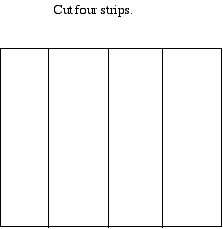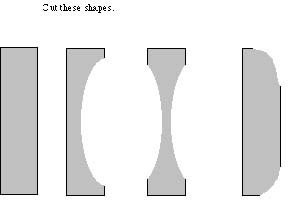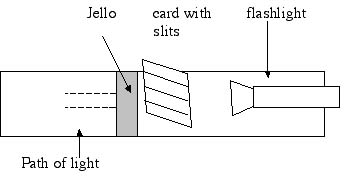TRB 6:6 - Activity 4 - Lemon Light
Summary
This activity will model different types of light refraction.
Materials
Websites
- 1 8 oz. package of lemon gelatin (Jell-O) mixed with 1.5 cups of boiling water (to make enough Jell-O for a class of 30, use 4 packages of lemon Jell-O and 6 cups of water and fill a 14 x 17 inch cookie sheet)
- can, hard plastic cup, or circular cookie cutter
- plastic knife-one per pair of students
- 3 x 5 card with 3 small slits cut in it (one per student pair)
- prism
- small flashlight (one per student pair)
- laser pointer (Due to potential safety hazard to eyes, laser pointer should be used by teacher only and with caution.)
- butcher paper or wax paper
- pencil
Additional Resources:
Fireflies in the Night by Judy Hawes; illusrtated by Ellen alexander Harper & Row, New York. 1963, 1991. Grades K-5
Einstein Anderson Sees Through the Invisible Man by Seymour Simon; illustrated by Fred Winkowski Viking Press, New York. 1983. Grades 4-7
Background for Teachers
Light moves in a straight line from its source unless it is refracted. Light can be bent or refracted by the medium it travels through. The refraction of light can be modeled in several ways. One way is to use a prism and shine a light through it. The colors are separated as each color bends at a different angle. Another way refraction can be observed is to look at a pencil that is placed in a cup of water. The pencil appears bent as the light waves slow down in the water. The path of refracted light can be seen through Jell-O. This activity will model different types of refraction.
Intended Learning Outcomes
1-Use science process and thinking skills
3-Understand science concepts and principles
4-Communicate effectively using science language and reasoning
Instructional Procedures
Attachments
Invitation to Learn:
- Use a laser pointer in a dark room. Point it across the room. Have a student clap two chalk erasers together near the beam of light. Ask students what they can observe about the light.
- Use a flashlight and shine it through the prism. Aim the refracted light at a screen or white wall. Ask students what they observe about the light.
- Demonstrate with a pencil and cup of water how the pencil appears to bend when immersed in water.
- Make a KWL chart about light. Students should list in columns what they know ("K") about the light and what they want ("W") to know. The "L" column will be filled in later with what they learned.
Instructional Procedures:
- Advance Preparation: Mix the Jell-O; pour Jell-O 1 1/2-inches thick into a shallow pan. Allow set-up the night before. A 14 x 17 inch cookie sheet makes enough for the whole class.
- Cover student desks with butcher paper or wax paper.
- Give pairs of students a flashlight, the 3 x 5 card and a square of Jell-O gelatin that is 4 inches square in size.
- Explain to students that light travels differently through different mediums. Have them predict what will happen to light as it travels through the Jell-O.
- Students will need to cut 4 strips from the Jell-O and lay them on the wax paper. Have students cut the strips into the shapes shown below (A). Use the can, cup or cookie cutter to cut circles on the edges of the strips to make the shapes on the following page ( B ).
(A)

( B ) Cut these shapes.

- The light must shine through the slits in the 3 x 5 card as it shines through the Jell-O.
- Students should draw the path of the light beams on the butcher paper as it leaves the Jell-O. They should record all observations in their journals.
- Finish the KWL chart at the end of the activity.
Extensions
Attachments
Students may wish to test the path of light through other transparent mediums.

Assessment Plan
The following rubric could be used or adapted for grading this activity.
Teacher Note: You will be assessing each student's progress on an ongoing basis. Use the response levels to help you evaluate the student's growth toward the Key Scientific Concepts, the Communication Characteristics and Learning Dispositions.
Response Levels:
- Accomplishes the purposes of the question, task or concept.
- Partially accomplishes the purposes of the question, task or concept.
- Shows fragmented understanding; uses vague scientific communication.
Key Scientific Concepts to Discover:
- Light may be bent or refracted by the medium through which it travels.
- Refraction of light is modeled in several ways.
- Refraction may be observed and documented.
Communication Characteristics:
- How complete were the student's recordings?
- Did the student's drawings make sense?
- Did the student's recordings reflect awareness of Key Scientific Concepts?
Learning Dispositions:
- Did the student show perseverance and attention to detail when working on the tasks?
- Did the student show awareness of science process as they worked on the tasks?
Bibliography
This lesson is part of the Sixth Grade Science Teacher Resource Book (TRB3) http://www.usoe.org/curr/science/core/6th/TRB6/. The TRB3 is designed to be your textbook in teaching science curriculum to your students. This book covers all the objectives of each standard and benchmark. If taught efficiently, a student should do well on the End-of-Level (CRT) tests. The TRB3 is designed for teachers who know very little about science, as well as for teachers who have a broad understanding of science.
Updated: 02/05/2018


 UTAH EDUCATION NETWORK
UTAH EDUCATION NETWORK

 Justin
Justin Braxton
Braxton Dani
Dani Kayla
Kayla Katie
Katie Matthew
Matthew Rob
Rob Val
Val
